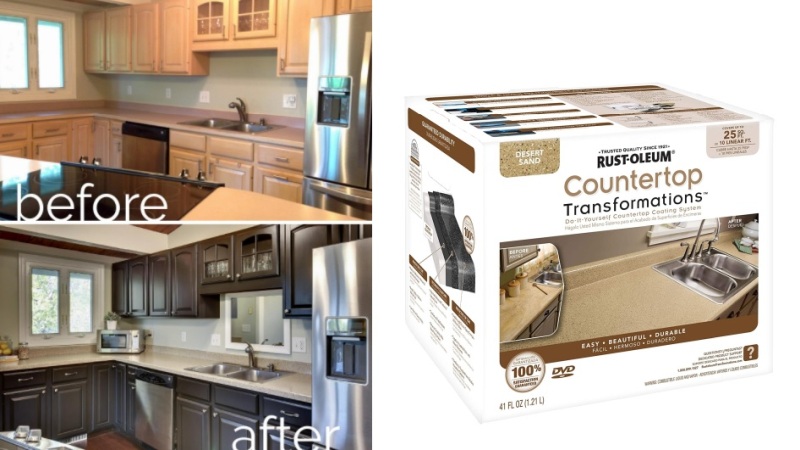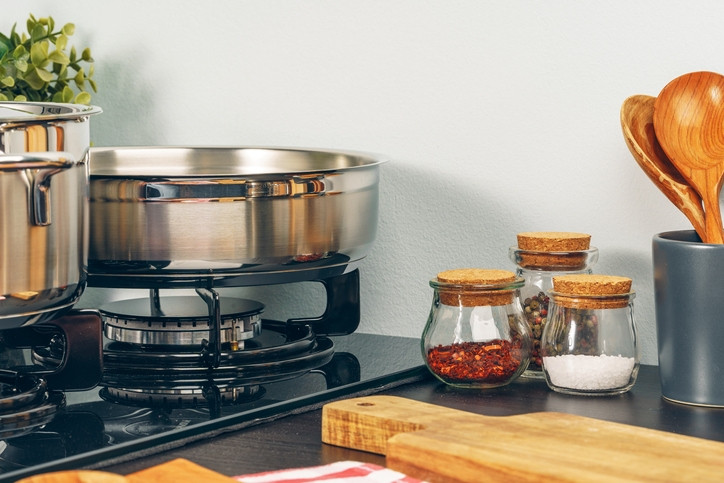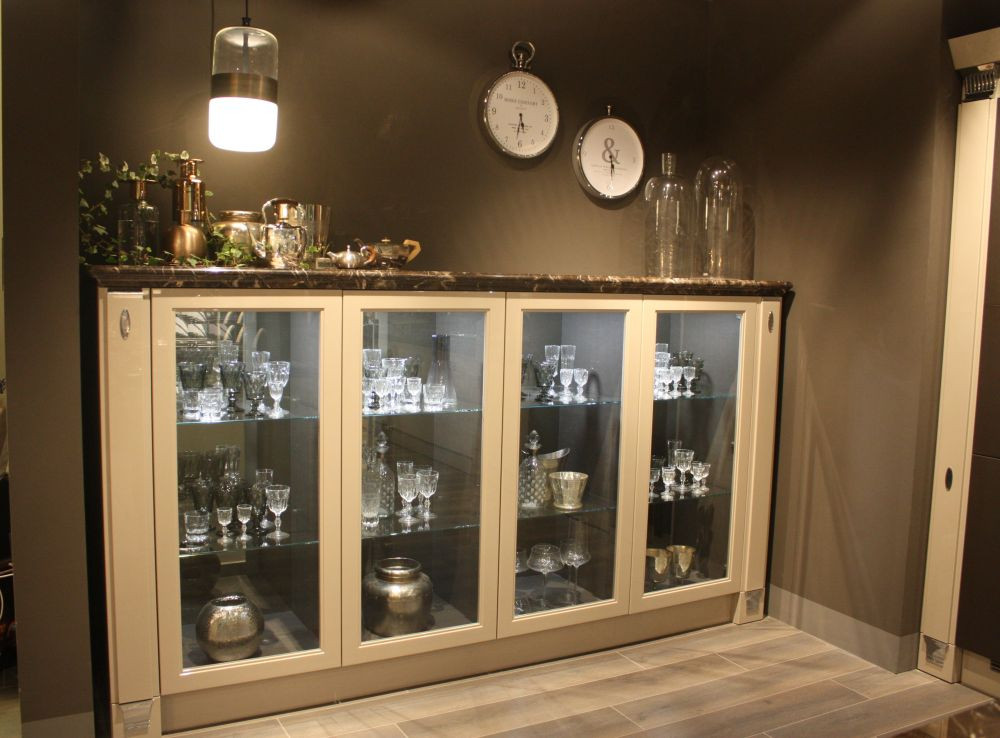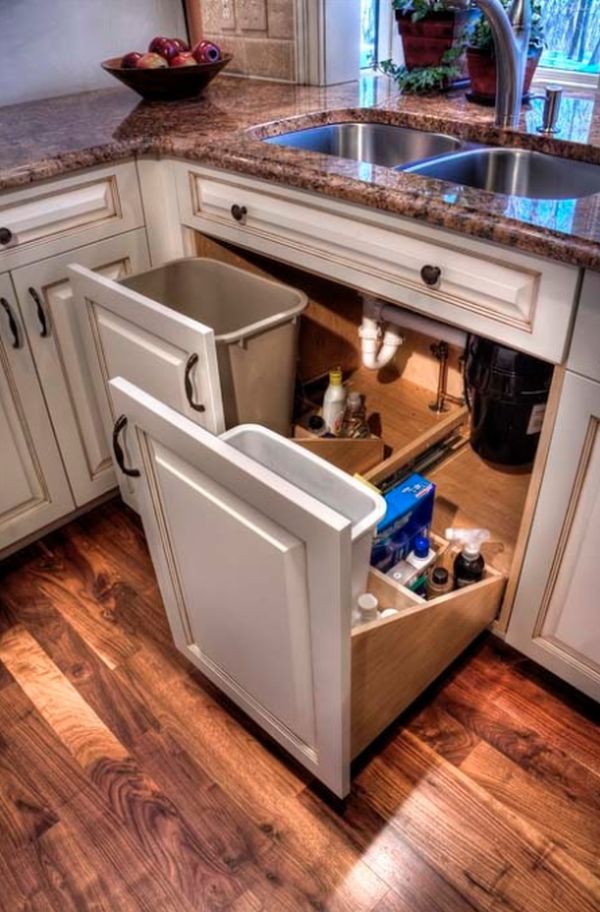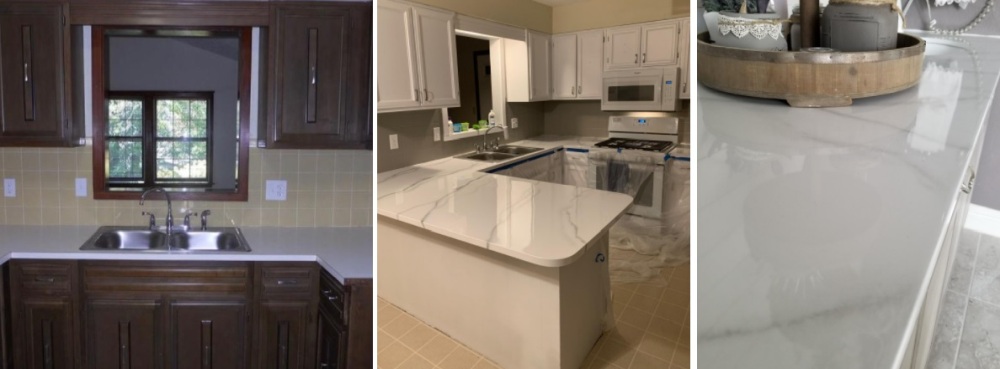
[ad_1]
Epoxy was first introduced to the public during the 1900s by a group of Russian chemists. In 1927, the first attempts to synthesize epoxy were made in the US.

Its various uses were mainly in the marine industry and, today, it has become a very common material for home renovations. Epoxy is often used for countertop refurbishing in kitchens and bathrooms across the US, which is why we’ve dedicated today’s article to help you find the best epoxy countertop kit.
Top 3 Picks
Best for Kitchen: Giani Carrara White Marble Countertop Paint Kit
The Giani Countertop Paint is one of the best products that you buy if you want to transform your kitchen countertops into a beautiful and long-lasting surface.
Best for Bathroom: Rust-Oleum Countertop Transformations Kit
Countertop Transformations is an easy-to-install product that gives your old bathroom countertops a new look. This kit comes with various tools and materials to complete the job.
Best Budget Option: Clear Table Top Epoxy Resin
This product is ideal for staining and protecting wood, bar, and tabletops. It creates a glossy surface that is durable and looks great when fully cured.
What Are Epoxy Countertops?
Known for its high-quality adhesive properties, epoxy resin has been used in various industries for a long time. Epoxy resin is a versatile material that can be used for various applications. It features a high-quality structure and strong adhesion.
When you want to choose the “easy way out”, you can opt for quartz, granite, or laminate countertops because you can purchase premade slabs that are relatively easy to install. You don’t get that benefit with epoxy. It is, rather, a sort of refinishing substance that you purchase in the form of a kit and then use to repair an existing material.
It’s true that there are premade epoxy countertops that you can purchase but the price is considerably higher and not suitable for people who are on a budget. Customers frequently install an epoxy countertop over another one with a worn-out material, which is commonly wood, ceramic, or concrete. This results in a bright, glossy coating that protects the surface beneath.
Pros & Cons to Epoxy Countertops
When you want to give your kitchen a new vibe, epoxy is a material that can go a long way in making you feel like you’ve bought new furniture. Naturally, there are ups and down to epoxy countertops, so let’s talk about them:
Pro: Works with a variety of countertop materials. Because of the resin’s longevity, epoxy countertops are often the go-to choice for many people for refurbishing projects. It can withstand scratches and stains just as well as other surface materials used in the kitchen. This material can even withstand the majority of typical home chemicals found in cleaners without losing its shine.
Con: Epoxy doesn’t pair well with marble or granite. Although the epoxy restoration technique may potentially be used on granite and marble, there are superior ways of refinishing that can restore the shine of these materials. The purpose of applying epoxy in the first place is to restore the original appearance of your countertops after installation. Because of the unique nature of marble and granite, they do not require repair, but you may consider utilizing them if you have a resin-based counter.
Pro: It provides a heat-resistant surface. One of the biggest benefits of having an epoxy countertop in the kitchen is its excellent heat resistance. Naturally, you can’t just place a hot pan on your epoxy countertop and leave it there forever because the heat will still destroy the initial layer, but the multiple layers of epoxy do a great job in protecting your counter.
Con: There is VOC released during the curing process. When epoxy cures, it creates a non-toxic surface that you can use to prepare your food. However, the chemicals that come together to form the hard, durable end result do include some volatile organic compounds (known as VOCs). When you’re pouring and waiting for epoxy to cure, make sure there is enough ventilation in the kitchen to allow the VOCs to dissipate. You should avoid utilizing that area for approximately a week following to verify that it is free of this possible contaminant.
Pro: Epoxy surfaces are very easy to clean. If you’ve decided to install an epoxy countertop in your kitchen, you may use nearly any cleaning agent on it without fear of harming it (with the exception of abrasive products which can produce minor scratches). That means you’ll always have a safe location to prepare food or go about your regular activities. Because it provides a nonporous surface with a range of fundamental materials, mold and bacteria development is minimized with this choice.
Con: Preparing the surface is time-consuming. If you’re determined to refurbish your countertops using epoxy, you must first prepare the surface accordingly and this process takes up quite a lot of time. To guarantee that no stains remain, your countertops may need to be carefully sanded. The majority of your room will next need to be covered with plastic to protect it from leaking and probable VOCs released during the application procedure. It also takes around 24 hours for the surface to cure before you can use it, and this could be a problem when you have to prepare food and you can’t use any of your countertops.
What to Consider Before Buying an Epoxy Countertop Kit
Epoxy seems like a great way to protect your countertops but there are a few things that you should know before buying a countertop resurfacing kit:
- Even if it has many different applications, epoxy can be used to repair or protect already existing surfaces. It is suitable for use with all types of laminate and composite countertops, as well as stone, concrete, or wood. You also have the possibility to pour a completely new countertop made with epoxy if you feel that works best for you.
- A few things spring to mind while contemplating application ease. Some of the best products that fall under this category have a relatively low viscosity level, which means they flow easily and level themselves. They’re considerably easier to utilize as a do-it-yourself project, especially if you’re trying epoxy for the first time.
- Since you will most likely need to apply a second coat of epoxy to your countertop, cure time is a key issue. Rapid-drying epoxy resins may require 4 to 6 hours before applying a second coat, but most experts suggest allowing the surface to dry for a full day. DIYers will most likely have to wait about 3 or 4 days before they can utilize the countertop. Even so, experts recommend using it sparingly because a full cure might take anywhere from 7 to 30 days, depending on the substance.
- When fully cured, epoxy resin has a high-gloss sheen that is resistant to water, ordinary wear, cracking, and scratches. While a pan fresh from the oven might burn it, it usually withstands heat well enough to allow cups carrying hot liquids to sit on it. Resistance to UV radiation in sunshine varies, however, this may not be an issue depending on location. If the countertop will be exposed to the elements, you can either purchase resin with UV protection or a coating of UV-resistant urethane varnish. Note that not all epoxy countertop kits are designed for outdoor use, so if you’re looking to renovate your outdoor kitchen, pay close attention to this specification before buying a certain product.
- When set, epoxy resins are nontoxic (because they’re theoretically an inert plastic) but they’re not always FDA recognized as food safe. Many goods do comply with the appropriate certification, so keep this in mind if the planned usage is for a kitchen countertop.
- Epoxy countertops are very resistant to moisture and stains, making cleaning a breeze. When possible, clean up spills immediately away. If a towel and warm water aren’t enough to erase the stains, try a little dish soap. You want to use a white cloth when cleaning these surfaces to prevent the color of the fabric from transferring to the surface. Acetone and glass cleaner can be used to remove more persistent stains. Another option is to dilute baking soda with water. Bleach should be avoided since it can discolor epoxy. Never use abrasive cleaners since they can leave microscopic scratches on the surface, causing it to dull over time.
How to Use an Epoxy Countertop Kit
You should know that an epoxy countertops kit generally comes in the form of a bottle or box with a product that you apply to your kitchen countertops per the manufacturer’s directions.
There are many different varieties of epoxies, but they all mix hardener and resin to create a transparent, long-lasting solid. As a first seal, typical instructions call for saturating the countertop material with a thin coating of epoxy. With this process, you can avoid bubble formation as you apply more coats of epoxy on top. However, this isn’t as easy as it may sound.
Installing an epoxy countertop using a kit is a meticulous process and every step needs to be carefully followed if you want to be satisfied with the result. An epoxy countertop kit can be installed in different ways and the manufacturer’s instructions should always be the first thing you consult. Today, we’re going to give you a general tutorial on how to use one of these kits.
The list of materials and tools needed for the project includes:
- 80- and 220-grit sanding sponge
- Drill
- 4 x 1-qt. Cups
- 2 x paddle mixers
- Isopropyl alcohol
- 2 x 2-gallon buckets
- Trim router
- Plastic sheet
- Spray bottle
- Orbital sander
- Oscillating tool
- 2 x 6-in. 3/8-in.-nap roller sleeves
- Painters tape
- Wiping cloths
- 6-in. paint roller
- Brushes
Once you have all these materials next to you, here are the steps to follow:
- Epoxy bonds well with rounded edges, which means that you can use a router with a round-over bit in a horizontal position to create a front rounded-over edge.
- Use all-purpose body filler to cover seams and gaps. If you have a particle board left exposed when cutting or routing, make sure to fill it out and smooth it as well.
- When all these gaps have been filled, proceed to sand the surface to make sure everything is smooth. Use 60-grit sandpaper for this process.
- Tape plastic to the floor underneath the counters. Roll the plastic over the bottom edge of the cabinet, and then tuck it in the toe-kick.
- Have all your materials prepared because timing is everything when pouring epoxy. As you apply the primer, the race begins.
- This primer is a must-have for any epoxy project. Mix a couple of parts into a small bucket and roll it on the counters. Once the old color is gone, apply more primer.
- The primer should cure for about an hour. To avoid staining, mix the metallic powder into the highlight epoxy.
- After about an hour, the primer is tacky and won’t leave residue on the surface. Mix the base coat with a clean, non-slip cloth or a glove. Pour the resin over the top of the counter, and then spread it around with a rolling pin. The goal is to create a layer that’s as thick as possible.
- Use a thin line of leftover epoxy to push the front edge of the counter. Once the base coat is even, move the base coat around or add more epoxy.
- Drizzling the highlights is a great way to add a little bit of color, but make sure to keep them balanced.
- By using a brush and dragging it across the top, you can feather the highlights for a beautiful end effect.
- The metallic powder and isopropyl alcohol solution give a more natural look to the epoxy. You can use the isopropyl alcohol and spray it across the surfaces to give the countertop a more natural stone-like appearance.
- Pay close attention to the counters in the upcoming hours and remove any epoxy drips as they occur. You’ll also need to remove the masking tape that’s holding the epoxy in place. Once the counters are ready, start filling them with the remaining epoxy.
- The next day, prepare the counters for the protective topcoat. This is usually done around 20 hours after the pour so that the bond will form and the epoxy has time to cure. Sand out any dust nibs you find on the counters using 220-grit sandpaper.
- Mix the two-part coat and apply it to the surface. Roll the coat over the top of the surface. Use the backsplash as your guide. Once the counters are completely cured, pull the roller to the front edge.
Best Epoxy Countertop Kits
Giani Carrara White Marble Epoxy Countertop Kit
Giani Countertop Paint is a three-step process that will transform countertops made with cultured marble, ceramic tile, Corian, Formica, laminate, and others, into a beautiful and durable surface. The Giani Countertop Paint Kit comes with all the necessary tools and supplies to properly coat and protect your kitchen countertops. This product is safe for interior use and doesn’t emit a strong odor since there are no VOC emissions. The kit also contains an Epoxy Resin Topcoat product to create a beautiful finish that’s resistant to everyday use.
Giani Countertop Paint Kit
Another product by Giani is this countertop paint kit that comes with a paint sponge, a foam brush, a roller arm with pads included, 16 oz. of glitter topcoat, 4 oz. of bronze mineral, 6 oz. of Black Onyx Mineral, 6 oz. of Pearl Mica Mineral, and 12 oz. of IronCore Primer-Base Coat. This stunning black granite accent features a starry finish and pearl flecks. There are other color options to choose from, including white diamond, slate, Sicilian sand, and chocolate brown.
Rust-Oleum Countertop Transformations Kit
Countertop Transformations is a simple and affordable way to transform a worn and outdated kitchen or bathroom countertop. It’s an easy and cost-effective way to give your countertops a natural look. This durable finish will not fade or stain. The kit is pretty generous too, as it comes with decorative color chips, wetting agent, adhesive base coat, protective topcoat, stir sticks, a diamond-embedded sanding tool, and a sanding block. The additional material’s list includes smooth painter’s tape, two synthetic brushes, two paint trays, a foam roller, a microfiber roller, protective sheets, and personal wear, and lint-free rags.
Clear Table Top Epoxy Resin That Self Levels
This particular epoxy-based product is formulated to give a smooth finish and minimize bubbles. It is ideal for use on wood, bar, and tabletop surfaces. When fully cured, it creates a glossy surface that excels in durability and makes your kitchen appear brand new. If there’s any leftover material, you can always use it in your art projects. It is a food-safe product and delivers a self-leveling formula that makes it very easy to apply.
DIY Project Ideas for Countertops
Easy DIY Countertop Refinishing

Refinishing your countertops is another brilliant idea for those of you interested in DIY projects to improve your home. For this project, you will be required to invest in Daich Coatings Mineral Select SpreadStone Countertop Finishing Kit, but also a bunch of other tools and products, such as a degreaser, a sanding block, an orbital sander, and a power drill. Some other tools that you’ll need and most likely have around the house include a broom/vacuum cleaner, a power drill with a paint stirring attachment, and a dust mask.
How to Refinish the Bathroom Vanity Top with Epoxy Resin

What if we told you it is possible to remake your bathroom vanity tops for just $140 and it doesn’t take more than 12 hours. The project uses epoxy resin to refinish the vanity tops, as epoxy resin works with materials such as ceramic, concrete, laminate, or wood. Unlike the two former projects, this one is going to take more materials and tools, such as a propane torch, a drill, a sander, utility knife, chop brush, silicone caulk, painter’s tape, primer, and others.
Countertop Resurfacing with Metallic Epoxy

When it comes to DIY projects, some people feel that no written instructions or images could ever replace video instruction, so here is a YouTube video that teaches you how to resurface countertops using metallic epoxy. While some would argue that this is a more meticulous project, it’s definitely one that makes a mess.
FAQ
How much does it cost to epoxy a countertop?
Kits designed to cover your countertops in epoxy can cost between $50 to $250, which means you can get really good products for around $150 to $180.
Do epoxy countertops scratch easily?
Epoxy is one of the most durable materials that you can use for a countertop and it will not scratch easily unless you plan on cutting bread directly on the counter instead of using a cutting board underneath.
Is epoxy good for countertops?
Yes, epoxy provides a lot of benefits when used as a countertop material, from its heat and scratch resistance to the fact that it can easily be cleaned.
Are epoxy countertops cheaper than granite?
Epoxy countertops usually cost around $45 per square foot. Granite prices also start at $45, but they can go as high as $225. Overall, that makes epoxy cheaper than granite.
Conclusion
With epoxy resin, you can transform an old countertop into a modern masterpiece. This material is durable enough to last for many years, and it can be used to make a new countertop that’s as beautiful as real stone. Since epoxy has become more prevalent, there are a number of different resins to choose from. This article will help you narrow down the options and find the right one for your project.
[ad_2]
Source link



